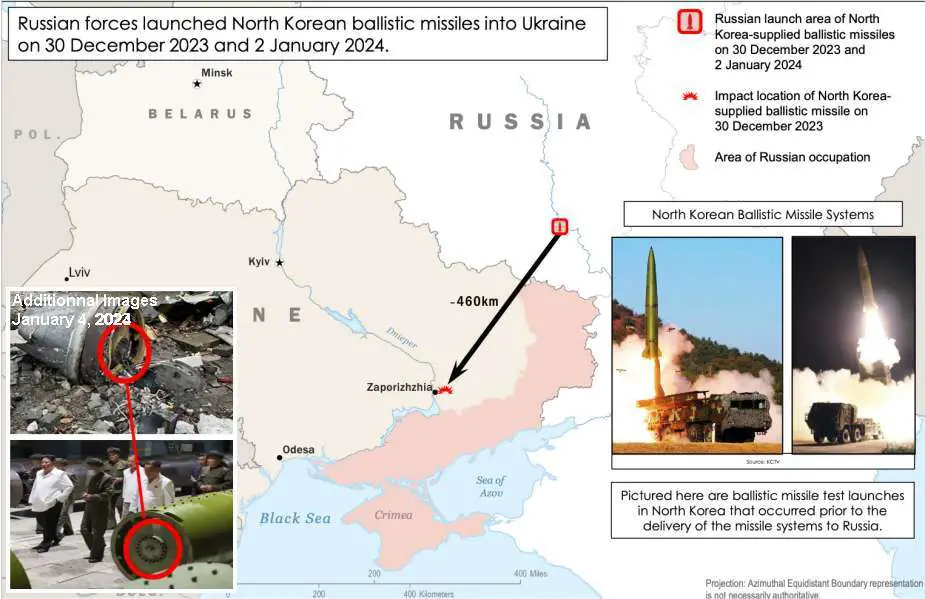Breaking news
Breaking News: Ukraine Confirms Use of North Korean Missiles by Russia in Recent Strikes.
According to images released by the International Press Agency Reuters on January 6, 2024, it has been confirmed that Russia used North Korean-made ballistic missiles in a strike on the Ukrainian city of Kharkiv on January 2, 2024. These pictures, featured in a Reuters article, show clear markings in North Korean characters on the missile debris. Notably, the design of the rear of the missile debris bears a striking resemblance to the North Korean-made KN-23 ballistic missile.
Follow Army Recognition on Google News at this link

Left: Additional images have been released following John Kirby's press conference, showing missile debris found in Ukraine and comparing it to the North Korean KN-23 missile. On January 4, 2024, the United States disclosed a photo showing the use of North Korean missiles by Russia against Ukraine. (Image source: U.S. Government video footage)
This significant revelation was further supported by statements from John Kirby, the United States National Security spokesperson, during a press conference on January 4, 2023. Kirby announced that Russia has recently employed short-range ballistic missiles (SRBMs) sourced from North Korea in multiple strikes against Ukraine. Declassified photos indicate Russian use of North Korean-made missiles as early as December 30, 2023, and again on January 2, 2024. These missiles were reportedly launched from Russia towards the area around Zaporizhzhia, a key city in southeast Ukraine located on the banks of the Dnieper River.
Additionally, images accompanying the Reuters article also showed KN-23 and KN-24 ballistic missile launchers, raising suspicions that these systems might have been delivered to Russia.
In the same Reuters article dated on January 6, 2024, a Ukrainian expert displayed images of missile debris, which are visually and technically distinct from Russian models. The debris appears to be a variant of the Russian Iskander-M ballistic missile. Notably, North Korea has developed the KN-23 as a variant of the Russian Iskander.
in November 2023, South Korean intelligence indicated that North Korea may have been involved in a comprehensive arms deal with Russia. This deal reportedly included the supply of short-range ballistic missiles (SRBMs), as well as a range of other military equipment such as anti-tank and anti-air missiles, artillery, mortar shells, and rifles. This arms transfer represents a major escalation in military cooperation between the two nations, reflecting their increasingly synergistic defense strategies.
The logistics of this arms transfer were noteworthy. An estimated 2,000 containers were shipped from Rason port, located on North Korea's northeast coast, which is a known node in Russia's military logistics network. This movement of arms was monitored and analyzed through satellite imagery and reports from Western researchers. Specifically, the KN-23 ballistic missiles, a key component of this shipment, are believed to have been manufactured at an armaments factory in Sinhung, North Korea.
There is speculation that these missiles were subsequently shipped to Russia soon after their production in 2023. In return for this significant supply of arms, North Korea is purportedly seeking military aid from Russia, including fighter aircraft, surface-to-air missiles, armored vehicles, and other sophisticated military technologies and equipment. This arms deal underscores the deepening military and political ties between Russia and North Korea, both of which face political and economic isolation on the global stage.
The KN-23 was first showcased during a North Korean military parade in 2018 and entered service between 2019 and 2020. It represents a significant advancement in North Korea's missile capabilities. Conceptually similar to the Russian Iskander and the South Korean Hyunmoo 2, the KN-23 was developed with the assistance of Russia and China. This development marks a concerning escalation in the Ukraine-Russia conflict, with implications for global security dynamics.
In terms of its range, the KN-23 is reported to have a range of approximately 450 kilometers (about 280 miles), though there may be variations depending on the specific configuration and payload of the missile. This range places it within the category of short-range ballistic missiles, suitable for targeting locations within a regional scope. The development of the KN-23 signifies North Korea's ongoing efforts to advance its missile technology and enhance its military capabilities.
The KN-24 is another significant ballistic missile in North Korea's arsenal, akin to the U.S. MGM-140 Army Tactical Missile System (ATACMS). As a short-range ballistic missile (SRBM), the KN-24 is designed to evade missile defenses by flying on a flatter trajectory than traditional ballistic missiles, a characteristic that makes it a strategic asset in North Korea's military capabilities. This missile represents North Korea's continuous efforts to enhance its missile technology, particularly in developing systems that can potentially bypass missile defense mechanisms.
In terms of range, specific details about the KN-24's capabilities are less clear in open sources. However, given its categorization as a short-range ballistic missile and its comparison to the ATACMS, it can be inferred that its range would be within the typical spectrum for SRBMs, which generally spans up to 1,000 kilometers (about 620 miles). The exact range could vary based on the missile's design and payload. The development and operational deployment of the KN-24, alongside other missiles like the KN-23, underscore North Korea's focus on diversifying and advancing its missile arsenal to bolster its regional military posture and deterrence capabilities.
Defense News January 2024























